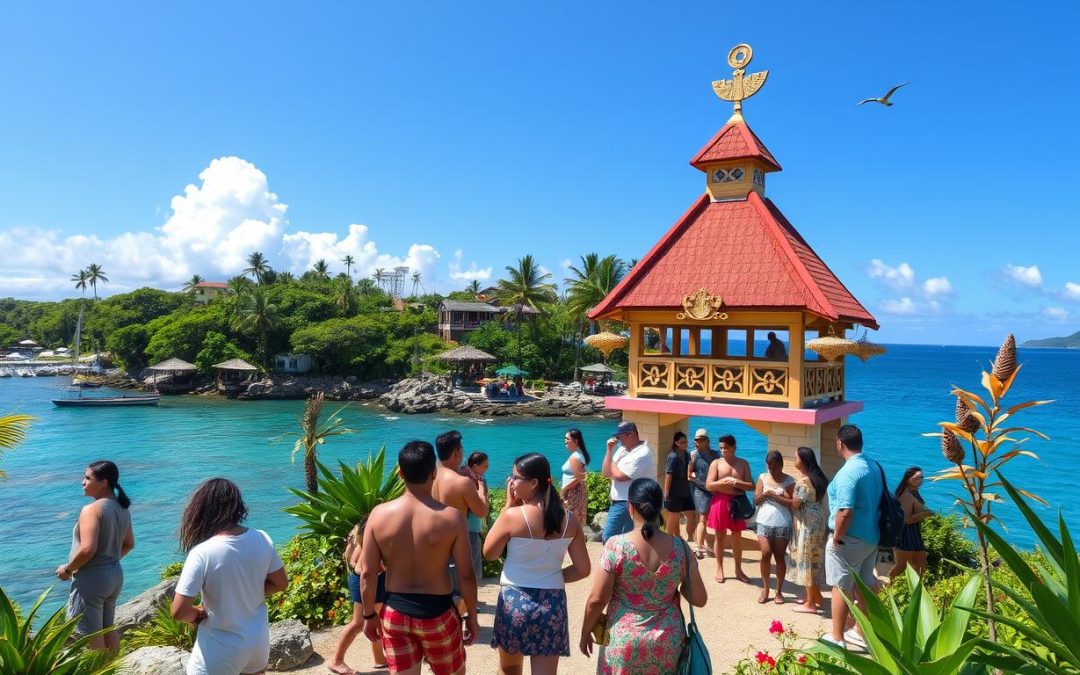Ever wondered about the language diversity of a small Pacific island? Guam is a treasure trove of languages, each telling a story of cultural richness and resilience.
Guam’s language scene is a colorful mosaic of its complex history. As a U.S. territory, it has two official languages: English and Chamorro. These languages are at the core of Guam’s communication, each with its own cultural tale.
English is the main language in official settings, spoken by 43.6% of the people. Chamorro, the native tongue, holds the island’s cultural roots. Filipino, spoken by 21.2% of the population, adds another layer to Guam’s language diversity, showing the significant Filipino community.
Key Takeaways
- Guam has two official languages: English and Chamorro
- English is spoken by 43.6% of the population
- Chamorro represents 17.8% of language usage
- Filipino is widely spoken, representing 21.2% of languages
- The linguistic diversity reflects Guam’s rich multicultural heritage
Understanding Guam’s Linguistic Heritage
Guam’s language story is one of cultural strength and change. Exploring the island’s language diversity shows a mix of historical influences. The island’s language reflects its long history of global interactions and cultural preservation.
The Chamorro language is at the core of Guam’s identity. It has been spoken by the island’s people for thousands of years. This language has survived through many changes, showing the island’s cultural depth.
Historical Language Evolution
Guam’s language journey has key moments:
- Indigenous Chamorro language established circa 2000 BC
- Spanish colonial period introduced European linguistic influences
- U.S. territorial status brought English as an official language
- Japanese occupation during World War II added another linguistic layer
Colonial Language Impacts
Different colonial powers have shaped Guam’s language. The Spanish brought European words, while the U.S. made English key. These changes created a unique mix of languages.
| Language | Percentage (2010) | Cultural Significance |
|---|---|---|
| English | 43.6% | Official government language |
| Chamorro | 17.8% | Indigenous cultural preservation |
| Filipino | 21.2% | Immigrant community communication |
Cultural Significance of Language Diversity
Language in Guam is more than just talking. It’s a link to the island’s heritage. Keeping the Chamorro language alive shows Guam’s cultural strength. Efforts in education and community help keep the island’s language traditions alive and important.
“Language is the road map of a culture. It tells you where its people come from and where they are going.” – Rita Mae Brown
Official Languages of Modern Guam
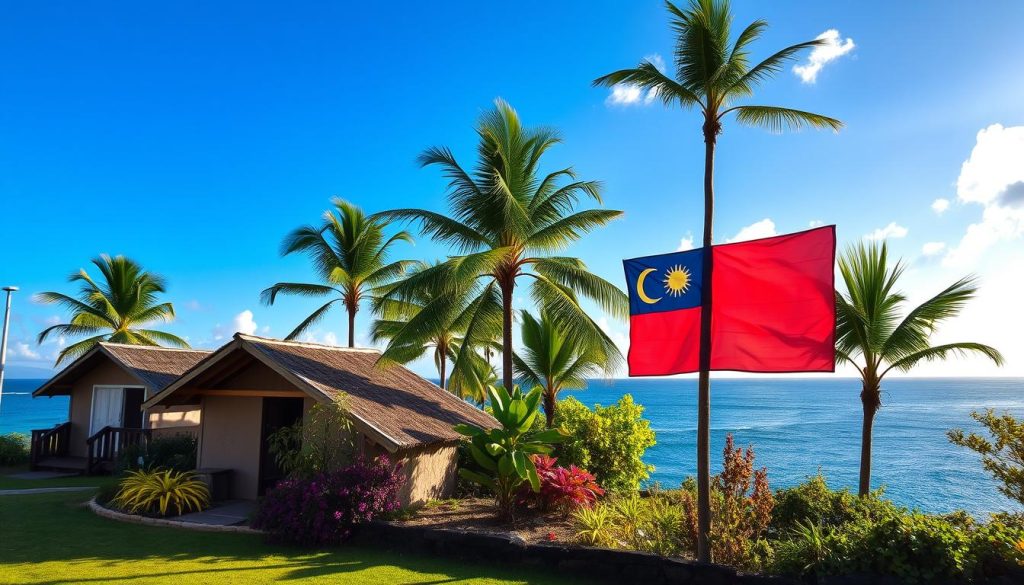
In Guam, two languages are key for official talks: English and Chamorro. These languages show Guam’s rich history and culture. They are important for this U.S. territory in the Pacific.
Guam’s language history is complex. Chamorro, the native tongue, was renamed CHamoru in 2017. This move helped keep the culture alive. Today, about 40.3% of Guam’s people are Chamorro, with 17.8% speaking the language at home.
“Language is the road map of a culture. It tells you where its people come from and where they are going.” – Rita Mae Brown
- English is the main language for government and schools
- CHamoru is a big part of Guam’s culture
- Official status helps keep language diversity alive
Despite past challenges, like a ban in 1917, CHamoru is still strong. Programs like the P.C. Lujan Elementary School in Barrigada help keep the language alive for the young.
The mix of English and CHamoru in Guam is special. It honors the island’s roots and meets today’s communication needs.
The Chamorro Language: Indigenous Identity
Guam’s indigenous language is a treasure rich in history. The Chamorro language is a symbol of native identity. It connects generations through its unique heritage.
The Chamorro language has about 58,000 native speakers worldwide. UNESCO says it’s vulnerable, showing the need for urgent efforts to save it.
Traditional Chamorro Vocabulary and Structure
The Chamorro language is complex. It mixes:
- Indigenous Mariana Islands language roots
- Spanish colonial loanwords
- Modern linguistic adaptations
“Language is the roadmap of a culture. It tells you where its people come from and where they are going.” – Rita Mae Brown
Current Usage and Preservation Efforts
The Chamorro language is in a critical state:
- Only about 20% of Chamorros speak it fluently
- Most fluent speakers are over 55
- Now, laws require teaching Chamorro in schools
Common Chamorro Phrases for Visitors
Learn basic Chamorro phrases to connect with locals:
- Håfa adai – Hello
- Si Yu’us Ma’åse – Thank you
- Guahu – Me/I am
By learning the Chamorro language, you help preserve this valuable treasure.
English Language Usage and Influence
English is key in Guam’s multilingual society. It’s used everywhere, thanks to the U.S. military and education. These factors have made English a major part of life on the island.
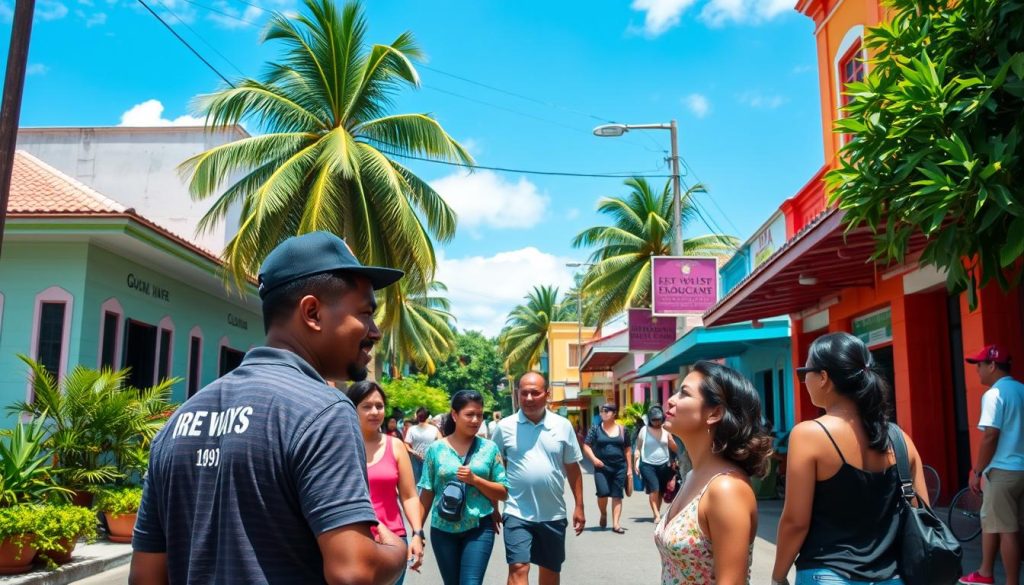
Eva Kuske’s research gives us a closer look at English in Guam. Her study, backed by the Swiss National Science Foundation, included:
- 38 hours of recorded interviews
- Over 62 participants
- Investigation of five unique English varieties in Micronesia
English in Guam is very flexible. The U.S. education system changed how people speak. Now, schools teach only in English.
The U.S. military presence led to a situation where English speakers outnumbered native Chamorro speakers on the island.
| Language Aspect | Details |
|---|---|
| Official Status | English is an official language of Guam |
| Research Focus | Emerging English varieties in Micronesia |
| Research Duration | Three-and-a-half year study |
Understanding English in Guam shows its importance in communication, education, and culture. It’s constantly changing, showing Guam’s lively language scene.
Filipino Languages in Guam’s Society
Guam’s language scene is rich and diverse, thanks to Filipino languages. The Filipino community is a big part of Guam’s people. They bring a lively language heritage that shapes how people talk.
Tagalog and Philippine Dialects
Tagalog is a big deal in Guam, thanks to its Filipino population. About 26% of Guam’s people are Filipino. They bring many Philippine dialects, adding to the island’s mix of languages.
- Tagalog is the most common Filipino language here.
- Other dialects include Ilocano, Cebuano, and Hiligaynon.
- Language diversity shows the rich culture of Filipino immigrants.
Community Language Impact
The Filipino community’s language has a big impact. It helps people connect and build community in Guam.
“Language is the roadmap of a culture. It tells you where its people come from and where they are going.” – Rita Mae Brown
| Filipino Population Milestone | Year | Number of Residents |
|---|---|---|
| Initial Migration | 1940 | 2.6% (approximately 579 people) |
| Post-War Growth | 1950 | 12.2% (7,258 individuals) |
| Recent Years | Present | Nearly 50,000 residents |
Cultural Integration Through Language
Filipinos have made their language a part of Guam’s culture. Cultural integration happens through language exchange and bilingual education. Community events also celebrate the diversity of languages. This has made Guam a vibrant, multicultural place where Filipino languages are valued.
Pacific Island Languages in Guam
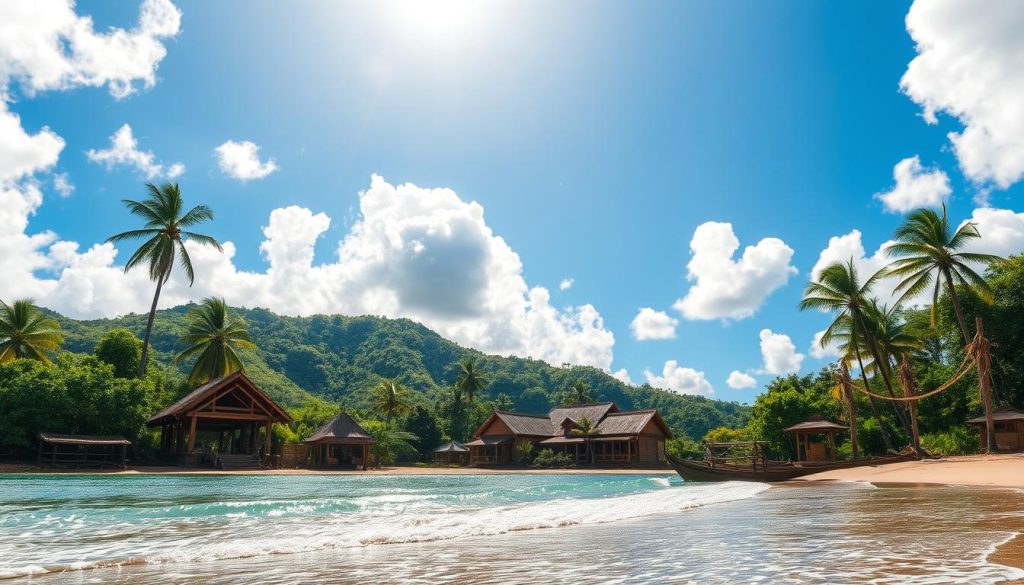
Guam is home to a wide range of Pacific Island languages. These languages show the rich cultural heritage of the Pacific. The island’s people speak many languages, showing their deep connection to the Pacific.
About 10% of Guam’s residents speak Pacific languages at home. This diversity highlights Guam’s ties to Pacific communities.
- Micronesian languages prominent in Guam include:
- Carolinian
- Chuukese
- Palauan
- Ponapean
- Polynesian languages represented:
- Hawaiian
- Samoan
- Tongan
These languages are key to keeping cultural identities alive. They connect Guam’s people to their past and heritage.
“Language is the roadmap of a culture. It tells you where its people come from and where they are going.” – Rita Mae Brown
| Language Group | Estimated Speakers | Cultural Significance |
|---|---|---|
| Micronesian Languages | Approximately 5-7% | Strong community connections |
| Polynesian Languages | Approximately 2-3% | Cultural preservation |
Understanding Guam’s languages shows a vibrant, connected community. They celebrate their Pacific language heritage. Keeping these languages alive ensures cultural traditions stay vibrant for the future.
Asian Language Presence and Communities
Guam’s language scene is a colorful mix of Asian influences. The island is home to Japanese, Korean, and Chinese communities. These groups add to Guam’s diverse way of communicating.
Asian languages in Guam come from history and today’s migration. About 10% of homes speak Asian languages, showing their big cultural role.
Japanese Language Legacy
The Japanese language has a deep history in Guam. World War II left a lasting mark. Some older folks still speak Japanese, keeping a link to that time.
- Japanese language roots trace back to the early 20th-century colonial period
- Older generations maintain linguistic connections to Japanese heritage
- Cultural exchanges continue to reinforce Japanese language presence
Korean and Chinese Speaking Populations
Korean and Chinese communities in Guam are growing. They bring new cultural ideas. These groups are key to Guam’s diverse communication scene.
“Language is the road map of a culture. It tells you where its people come from and where they are going.” – Rita Mae Brown
Exploring Guam’s languages shows how Asian tongues blend with local ways. Each community adds to Guam’s vibrant cultural mix.
Language Demographics and Statistics
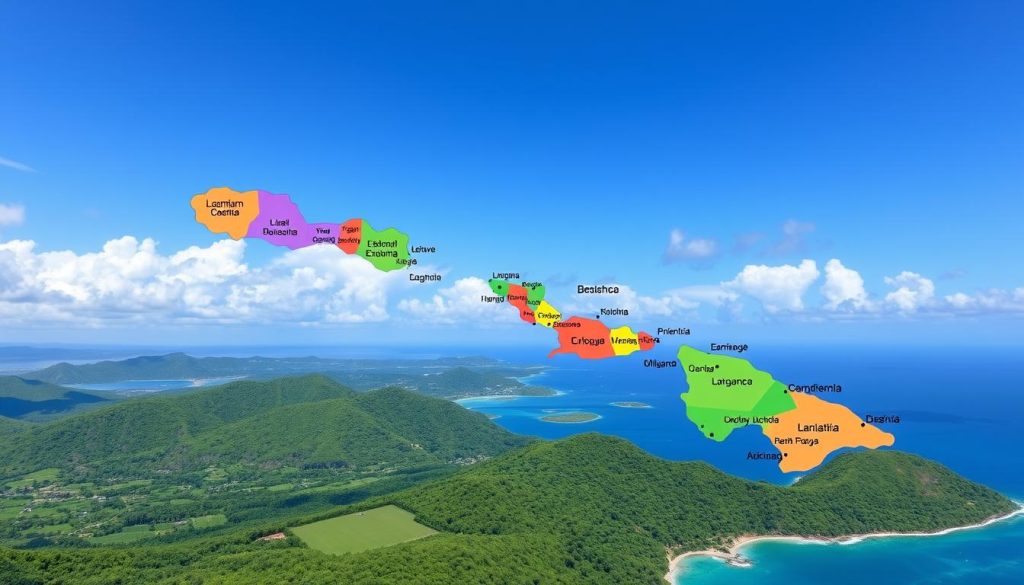
Explore Guam’s unique linguistic world. Here, a multilingual society and linguistic diversity weave a rich cultural fabric. The island’s language statistics show a mix of communication styles, reflecting its complex history and culture.
Guam’s language scene is complex and interesting. Recent data shows the island’s linguistic diversity:
- 57.3% of the population aged 5 and over speak a language other than English
- 65.9% of non-English speakers are fluent in English
- 42.8% of multilingual residents speak Philippine languages
The population breakdown shows Guam’s multicultural nature:
| Ethnic Group | Percentage |
|---|---|
| Native Chamorro | 37% |
| Filipino | 26% |
| Other Asian and Pacific Islanders | 33% |
Guam’s language statistics show its ability to keep its linguistic heritage alive. At the same time, it welcomes multilingual communication. The island’s mix of cultures ensures languages are key in community life.
“Language is the roadmap of a culture. It tells you where its people come from and where they are going.” – Rita Mae Brown
Understanding Guam’s language landscape gives us a glimpse into its vibrant society. The presence of many languages shows the island’s cultural richness and its dedication to linguistic diversity.
Language Education and Preservation Programs
Guam’s language scene is full of life and culture. It’s all about keeping the island’s rich heritage alive, especially for languages like Chamorro.
But, there’s a big challenge ahead. UNESCO says Chamorro is “vulnerable.” This means we really need strong language education programs.
School Language Programs
New ideas are coming to save Guam’s languages. P.C. Lujan Elementary in Barrigada is leading the way. It’s the first school to teach Chamorro full-time.
- Chamorro language curriculum development
- Bilingual education programs
- Cultural language integration strategies
Community Language Initiatives
But it’s not just schools. Community efforts are key too. Local groups are using fun ways to bring back indigenous languages.
“Language is the road map of a culture. It tells you where its people come from and where they are going.” – Rita Mae Brown
These efforts are important. With about 93,000 Chamorro people living away from Guam, keeping the language alive connects them to their roots.
Preservation Strategies
- Oral tradition workshops
- Digital language learning platforms
- Intergenerational language transmission programs
Your help and support are crucial. Together, we can make sure Guam’s languages live on for generations to come.
Conclusion
Exploring Guam’s languages shows a rich cultural scene. It reflects the island’s complex history. The Guam languages are more than just a way to talk; they are memories of the island’s diverse past.
From the indigenous Chamorro to English and other Pacific Island languages, this society is truly unique. It shows how cultural identity can survive through language.
Your trip through Guam’s language heritage shows how a small island can keep its cultural voice alive. Schools teach Chamorro from elementary to high school. This keeps the language alive and shows respect for the CHamoru people.
The language of Guam tells a story of strength, change, and pride. Despite challenges like Spanish rule, U.S. control, and Japanese occupation, the languages have thrived. Visiting Guam lets you see a special place where old traditions meet new cultures.
Learning about Guam’s languages is like reading a living history. Each word and dialect is a part of the island’s amazing story. It shows the power of cultural identity through language. Exploring Guam’s languages opens a window into its heart.
The above is subject to change.
Check back often to TRAVEL.COM for the latest travel tips and deals.
Here are some Tours & Sightseeing suggestions that might pique your interests!
